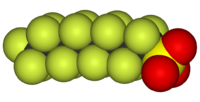
Photo from wikipedia
Per- and polyfluoroalkyl substances (PFASs), including perfluorohexanesulfonic acid (PFHxS), as emerging persistent organic pollutants widely detected in drinking water, have drawn increasing concern. The PFHxS contamination of drinking water always… Click to show full abstract
Per- and polyfluoroalkyl substances (PFASs), including perfluorohexanesulfonic acid (PFHxS), as emerging persistent organic pollutants widely detected in drinking water, have drawn increasing concern. The PFHxS contamination of drinking water always results from direct and indirect sources, especially the secondary generations through environmental transformations of precursors. However, the mechanism of the transformation of precursors to PFHXS during the drinking water treatment processes remains unclear. Herein, the potential precursors and formation mechanisms of PFHxS were explored during drinking water disinfection. Simultaneously, the factors affecting PFHxS generation were also examined. This study found PFHxS could be generated from polyfluoroalkyl sulfonamide derivatives during chlorination and chloramination. The fate and yield of PFHxS varied from different precursors and disinfection processes. In particular, monochloramine more favorably formed PFHxS. Several perfluoroalkyl oxidation products and decarboxylation intermediates were detected and identified in the chloraminated samples using Fourier-transform ion cyclotron resonance mass spectrometry. Combined with density functional theory calculations, the results indicated that the indirect oxidation via the attack of the nitrogen atom in sulfonamide groups might be the dominant pathway for generating PFHxS during chloramination, and the process could be highly affected by the monochloramine dose, pH, and temperature. This study provides important evidence of the secondary formation of PFHxS during drinking water disinfection and scientific support for chemical management of PFHxS and PFHxS-related compounds.
Journal Title: Environmental science & technology
Year Published: 2023
Link to full text (if available)
Share on Social Media: Sign Up to like & get
recommendations!